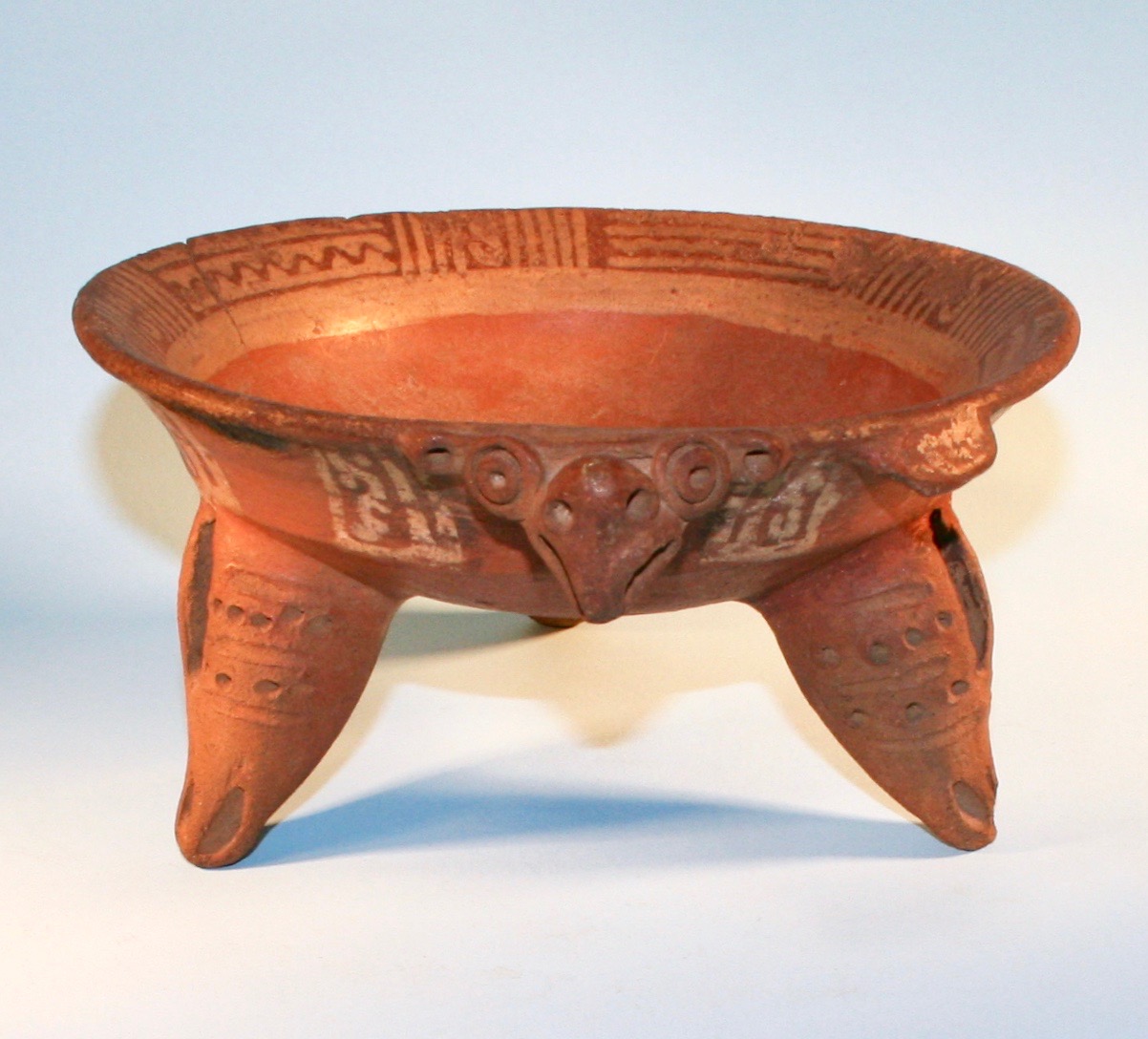

Title: Ancient Three Footed Terra-cotta Mayan Ceramic Bird Bowl
Shipping: $29.00
Artist: N/A
Period: N/A
History: N/A
Origin: North America > Mexico
Condition: N/A
Item Date: N/A
Item ID: 56
A great opportunity to own a piece of history. Ancient Three Footed Terra-cotta Mayan Ceramic Bird Bowl. Pottery Effigy Footed Bowl With Rattle Feet. Rare in and unusual example of American ancient ceramic pottery. Ceramics did more than hold things. For Classic Maya kings and queens, they served as markers of their wealth and as diplomatic gifts to cement loyalty with local governors. They were also performative, perhaps serving as guides for song or poetry during ceremonies. By the final centuries B.C., artists were engineering beautiful monochrome vases. The spectrum of slips on early pottery is limited to reds, creams, and blacks, but often potters would experiment with different firing temperatures and environments to create mottled surfaces, like red with black accents. Ceramic artists experimented with different forms on monochrome vessels, such as vertical fluting on the walls of tall vessels. Potters eventually added supports to wide plates and bowls. Around the first century A.D., ceramic vessels appear with enlarged, hollow supports with pellets inside. These pellets would have made noise with the movement of the vessel, transforming serving vessels into sonorous instruments at feasts or other rituals. Creativity abounds in the forms of monochrome footed vessels. Many of these vessels likely held alcoholic beverages in the form of fermented maize drinks or pulque, derived from agave. Many vessels also held foamy, savory chocolate beverages. Certain regions within the Classic Maya area developed distinctive styles of chocolate-drinking cups and bowls. All Maya pottery was built by hand as opposed to on a potter’s wheel. The process of creating ceramics involved many steps and different materials, both local and imported. Selecting the clays first, usually from local sources, potters would then fold in different tempers, or additives, to achieve a desired consistency or aesthetic quality. Tempers include such materials as crushed-up sherds (grog), ground limestone (calcite), or even volcanic ash, presumably imported from the volcanic landscape of the Guatemalan highlands. Before firing, the surface would be covered in slips, or mineral mixtures dissolved in water, created to give the vessels specific colors and brilliance. In the first millennium B.C., peoples speaking Mayan languages settled in agricultural villages across the Yucatan Peninsula. They began constructing monumental buildings, sculpting in various media, and creating durable containers out of fired clays. Ceramic vessels nourished in both life and death: they held food and drink for daily life, but also offerings in dedicatory caches and burials, which range from the simplest graves to the richest royal tombs.
Early experiments with polychrome vessels include a resist technique, using wax in conjunction with slips to produce patterns of positive and negative coloration. During the Classic Period, however, artists developed an extensive repertoire of polychrome vessels that were painted with a variety of geometric and figural designs. These artists seem to have been sponsored by the royal courts of self-proclaimed divine rulers at sites like Tikal and Calakmul. Ceramics became the canvases of artists to create scenes of myths, often dedicated to their patrons with hieroglyphic texts. Ceramic vessels transmitted these stories and amplified the accompanying performances up until the collapse of the Classic Maya political system in the ninth century.
Link: https://en.wikipedia.org/wiki/Maya_civilization
Ceramics are the most commonly surviving type of Maya art. The Maya had no knowledge of the potter's wheel, and Maya vessels were built up by coiling rolled strips of clay into the desired form. Maya pottery was not glazed, although it often had a fine finish produced by burnishing. Maya ceramics were painted with clay slips blended with minerals and coloured clays. Ancient Maya firing techniques have yet to be replicated. A quantity of extremely fine ceramic figurines have been excavated from Late Classic tombs on Jaina Island, in northern Yucatán. They stand from 10 to 25 centimetres (3.9 to 9.8 in) high and were hand modelled, with exquisite detail. The Ik–style polychrome ceramic corpus, including finely painted plates and cylindrical vessels, originated in Late Classic Motul de San José. Maya art is essentially the art of the royal court. It is almost exclusively concerned with the Maya elite and their world. Maya art was crafted from both perishable and non–perishable materials, and served to link the Maya to their ancestors. Although surviving Maya art represents only a small proportion of the art that the Maya created, it represents a wider variety of subjects than any other art tradition in the Americas.[185] Maya art has many regional styles, and is unique in the ancient Americas in bearing narrative text. The finest surviving Maya art dates to the Late Classic period. The history of Maya civilization is divided into three principal periods: the Preclassic, Classic, and Postclassic periods. These were preceded by the Archaic Period, during which the first settled villages and early developments in agriculture emerged. Modern scholars regard these periods as arbitrary divisions of Maya chronology, rather than indicative of cultural evolution or decline. Definitions of the start and end dates of period spans can vary by as much as a century, depending on the author.